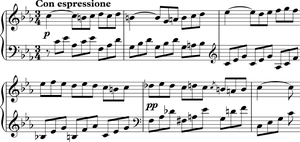Alberti bass


4 and 3
4[1] ⓘ and ⓘ




Alberti bass is a particular kind of
Classical era, and sometimes the Romantic era. It was named after Domenico Alberti (1710–1740/46), who used it extensively, although he was not the first to use it.[5]
Alberti bass is a kind of
broken chord or arpeggiated accompaniment, where the notes of the chord are presented in the order lowest, highest, middle, highest. This pattern is then repeated several times throughout the music.[5] The broken chord pattern helps to create a smooth, sustained, flowing sound on the piano. "Chords of harmony broken up into short patterns. Steady bass patterns in orchestral music which give the rhythmic drive to Classical music, compensating for the energetic drive of the Baroque basso continuo line."[6]
Alberti bass is usually found in the left hand of pieces for keyboard instruments, especially for Mozart's piano pieces. However, it is also found in pieces for other instruments. It has been described as, "a true tolerable monotony,"[7] and as "perhaps the most overworked fixture of eighteenth-century music."[8]
Well-known examples of Alberti bass include the beginning of
surf rock standard "Pipeline", by The Chantays.[10][11] Alberti bass is also used in the ending theme of Nintendo's Super Mario Bros. 2. [12][13]
Notes
References
- ISBN 9781457407482.
- ISBN 9781457410819.
- ^ ISBN 0-214-66680-8. "Examples of the Alberti bass...will be found...in the well-known C-major Sonata of Mozart (K. 545)."
- ISBN 978-0-07-310188-0.
- ^ ISBN 9780028654157.
- ISBN 9780435812584.
- ISBN 9789400953277.
- ^ ISBN 9781574674026. "But over and over again we can find Mozart using this figuration in such a way that it is transformed by the sheer beauty of his melodic invention above it."
- ISBN 9780521788625.
The first two bars of Mozart's Piano Sonata in C major K. 545... The passage consists of an Alberti-bass accompaniment supporting...[a] melody.
- ^ a b Overly, Mike (March 25, 2015). "Surfin’ With Mozart", 12ToneMusic.WordPress.com. Accessed: 21 July 2019.
- ISBN 9781538102152.
- ^ "Ending"
- ^ "Ending Theme - Super Mario Bros. 2"

